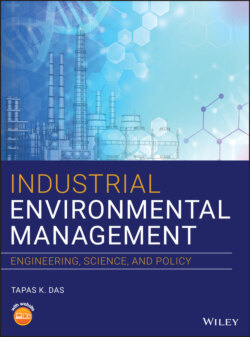Читать книгу Industrial Environmental Management - Tapas K. Das - Страница 36
1.11 Making the Transition
ОглавлениеThe shift toward a ZD culture, especially in a world dominated by industrial ecology, will see the development of new products, services, and industries. Our global economic system depends on extracting massive quantities of materials from the environment – after extraction and processing, the “annual accumulation of active materials embodied in durables, after some allowance for discard and demolition, is probably not more than six percent of the total. The other 94 percent is converted into waste residuals as fast as it is extracted” (Allen and Shonnard 2012; Allenby and Richards 1994; Ayres et al. 1996). In the United States, this means more than 10 T of “active” mass (excluding fresh water) per person each year.
Of this mass, roughly 75% is mineral and nonrenewable, and 25% is from biological sources. Of the biological materials, none of the food or fuel becomes part of durable goods and even most timber is burned as fuel or made into pulp and paper products that are disposed of. Of the mineral materials, about 80% of the mass of the ores is unwanted impurities, and of the final products, a large portion is processed into consumables and throwaways. Only in the case of nonmetallic minerals is as much as 50% of the mass embodied in durable goods such as cement and ceramics (Allenby and Richards 1994). All of this translates into an estimated more than 12 billion T of industrial wastes annually in the United States (Allen and Rosselot 1997).
In addition to materials lost as waste residuals during extraction and processing, finished goods are dissipated/lost because they are present in concentrations too small to be economically recoverable. Many products are inherently dissipative, and lost with a single normal use. These include packaging, lubricants, solvents, flocculants, antifreezes, detergents, soaps, bleaches, dyes, paints, paper, cosmetics, pharmaceuticals, fertilizers, pesticides, herbicides, and germicides. From one‐half to as much as seven‐eighths of the toxic heavy metals including lead, cadmium, chromium, cobalt, in insecticides (arsenic) and in wood preservatives, fungicides, catalysts, and plastic stabilizers are dispersed into the environment beyond economic recoverability. Other materials are lost to uses that are not inherently dissipative but are so in effect because of the difficulty of recycling. Allenby and Richards (1994) point out that the total elimination of manufacturing wastes probably is an unattainable goal because it would require, in addition to technological advances not yet in place, 100% cooperation by consumers.
